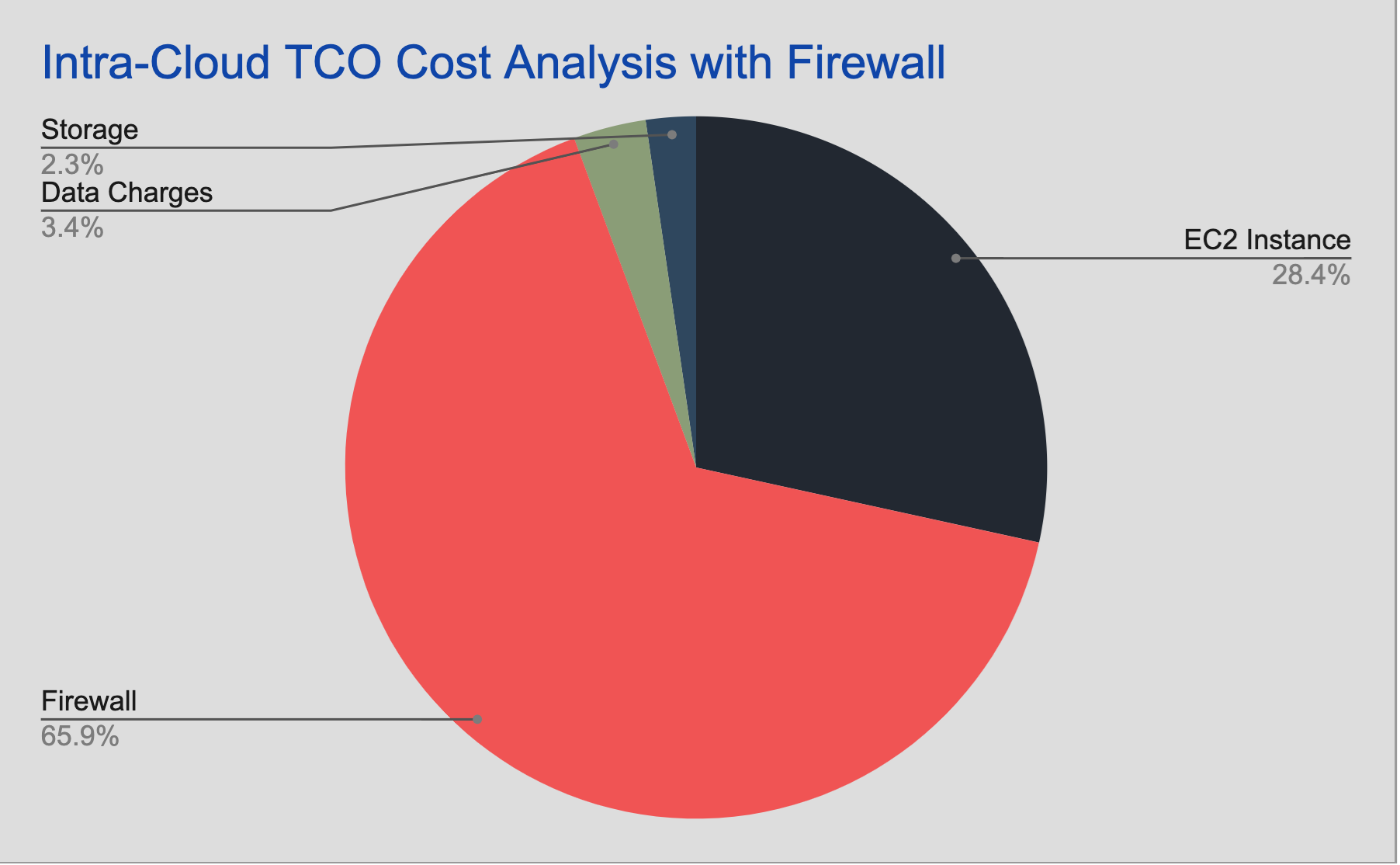Part 1: Calculate Intra-Cloud TCO

Disclaimer: This blog aims to educate the audience on calculating the Total Cost of Ownership (TCO) in the Cloud. This blog does not compare the Cost between CSPs; the example used below is just to show the calculation.
Big and Small Enterprises are either already in the cloud or plan to move to the cloud soon. Budgeting the Operational Expenses (OpEx) for planned workloads or architecture is vital for enterprises and one of the fundamental requirements of migrating to the Cloud.
Each cloud provider has unique pricing models, so understanding those models and factors affecting the cloud cost is very important to calculate the true cloud Total Cost of Ownership (TCO) of any solution.
This three-blog series will cover a high-level overview of factors that affect cloud costs in different scenarios like Intra-Cloud, Inter-Cloud, and On-prem Cloud. Then we will touch upon Multi-Cloud use cases and the TCO. Lastly, we’ll cover the Alkira NAAS solution, including Alkira’s tool for usage analysis and Cloud Insight, which will provide visibility into your cloud network and help you efficiently use your resources and optimize the operational cost.
This blog covers the different Intra-Cloud transit use cases, factors affecting the cost in those scenarios, and how to calculate the TCO for Intra-Cloud use cases.
Note: Kubernetes services are not part of this blog.
Factors Affecting Cloud Costs
Before we jump into different intra-cloud use cases and discuss calculating the TCO for those scenarios, we must understand various factors affecting cloud costs.
Let’s start with the Single Cloud vs. Multi-Cloud environment:
Single Cloud vs. Multi-Cloud
People presume that the Single Cloud solution will be cheaper than the Multi-Cloud environment, but this is not entirely true. Cloud TCO depends on data mobility and many other factors under Cloud Services. It is a fact that the cost variation per cloud provider creates complexity in calculating the TCO in a Multi-Cloud environment. Still, the business benefit of a Multi-Cloud environment is way more than a Single Cloud solution.
CapEx and OpEx
CapEx does not apply in the Cloud as cloud providers build the infrastructure, provide Infrastructure-As-A-Service (IAAS), and charge their customers for using their services; the more customers use, the more charges customers incur.
Similarly, OpEx in Cloud is also different; the Pay-As-You-Go (PAYG) model in the cloud is considered OpEx.
Cloud Services
Cloud service costs can be confusing and complex, but it is possible to calculate the TCO if one understands the resources used for their use cases.
The table below shows the resources examples and the factors that affect pricing:
| Services | Resources Affecting Cost |
|---|---|
| Compute |
|
| Storage |
|
| Networking & Security |
|
| Logging and Monitoring |
|
| Data Transfer |
|
Other Services Charges:
Calculating the true TCO is not straightforward, and it requires the complete hop-by-hop understanding of the data transition. There are costs besides Cloud Services, for example, Inter-AZ charges, Elastic IP charges, Network Address Translation (NAT) charges, CSP Transit charges, etc., that also affect the overall TCO. We will see more details about the data transition between CSPs or between Cloud and On-Prem in the next blog.
Human Capital:
Designing, deploying, and maintaining the exemplary architecture that fulfils all the company’s requirements takes time and energy. We often ignore the resources involved in the project and for how long in the TCO calculation.
Cloud Service Providers (CSPs) Calculators
Each CSP has shared the Calculator for their customer so that they can roughly estimate their budget:
Intra-Cloud Use Cases
The scenarios below focus on a single cloud for traffic flow between vpc/vnet/vcns using the recommended CSP transit construct.

Scenario 1: Intra-Cloud without Firewall Insertion
This scenario focuses on communication between workloads in a single cloud environment between multiple VPCs/VNETs. In this scenario, the traffic between these VPCs/VNETs is not being inspected by the firewall.
| Cloud Services & Parameters | Customer Requirements |
|---|---|
| Number of Region | 1 |
| Number of Instance per VPC | 1 |
| Bandwidth per Region | 500 Mbps |
| Data Transfer between VPCs | 5 GB/hour |
| Number of VPCs | 10 |
| Number of Instances | 10 |
| Total Number of Hours in a month | 730 |
| Total Number of Hours in a year | 8760 |
| EBS Storage | 100 GB |
Components Affecting Cost in Scenario 1
The components which will affect this scenario will be the CSP transit connection cost, data transfer charges and instance/virtual machine cost and storage costs associated with the instance/virtual machine.
AWS
| S. No | Cloud Components | Unit Price |
|---|---|---|
| 1 | TGW Attachments | 0.05/attachment |
| 2 | AWS Local Transit (TGW) – Data Transfer | 0.02/GB |
| 3 | EC2 Instance – C5.xlarge (On-Demand) | 0.17/hour |
| 4 | EBS Storage | $0.10 per GB-month of provisioned storage |
Cost Calculation:
| EC2 Compute Cost: | |
|---|---|
| EC2 Instance cost per month |
= EC2 Instance x Number of Hours / month
= 0.17 x 730
= $124.10 / instance
|
| Similarly, Total EC2 instance cost per year |
= EC2 Instance x Number of Hours/year
= 0.17 x 8760
= $1489.2 / instance
|
| Total EC2 Compute Cost for above scenario |
= $124.10 x 10 = $1,241 /month or
= $1489.2 x 10 = $14,892/year
|
| Elastic Block Storage (EBS) Cost: | |
|---|---|
| EBS Cost Storage per month Storage Used |
= No. of Instances x Storage Cost/GB x Storage Used
= 1 Instance x 0.10 USD x 100 GB
= 10.00 USD / instance |
| Total EBS Cost per above Scenario |
= 10.00 USD x 10 = $100/month
|
Data Transfer Cost within same region:
Data Transfer = 5 GB / hour
| Data Transfer Cost per hour |
= Data Transfer/hour x Data Transfer Cost / GB
= 5 x 0.02 = $0.1/hr |
| Data Transfer Cost per month |
= Data Transfer Cost/hour x Total no. of hours/month
= 0.1 x 730 = $73/instance |
| AWS Total Cost of Ownership (TCO) | |
|---|---|
| Total AWS TCO per month |
Total EC2 Compute Cost + Total EBS Storage Cost + Total Data Transfer Cost
= $1,241 + $100 + $73 = $1,414 / month OR
= $16,968 / year
|
Azure
| S. No | Cloud Components | Unit Price |
|---|---|---|
| 1 | Azure VNet Peering Data Transfer Cost | 0.01 |
| 2 | vWAN Hub (Standard Hub) | 0.25 |
| 3 | Azure vWAN Data Processing (VNet to VNet) | 0.04 (Includes #1 as well) |
| 4 | Virtual Machine – D4_v3 (PAYG) | 0.234/hour |
| 5 | Standard SSD 128 GB | 9.60/month |
| 6 | Storage Transaction | 0.0020 |
Cost Calculation:
| Azure Virtual Machine: | |
|---|---|
| Virtual Machine (VM) cost per month |
= VM Cost / hour x No. of Hours in a month
= $0.234 x 730 = $170.82 / instance |
| Similarly, Total VM cost per year |
= VM Cost / hour x No. of Hours in a year
= 0.234 x 8760 = $2049.84 / instance |
| Total VM Cost as per Above Scenario | = $170.82 x 10 = $1,708.2 /month OR = $2049.84 x 10 = $20,498.4/year |
| Standard SSD Cost: | |
|---|---|
| Standard SSD per month |
= Number of Instance x Standard SSD 128 GB
= 1 Instance x 9.60
= $9.60 / instance |
| Total Managed Disks Cost as per above Scenario |
= $9.60 x 10 = $96/month
|
Data Transfer Cost within same region:
Data Transfer = 5 GB / hour
| Data Transfer Cost per hour |
= Data Transfer/hour x Data Transfer Cost / GB
= 5 x 0.04 = $0.2/hr/instance |
| Data Transfer Cost per month |
= Data Transfer Cost /hour x Total No. of hours in a month
= 0.2 x 730 = $146/instance |
| Azure Total Cost of Ownership | |
|---|---|
| Total Azure TCO per month |
= Total VM Cost + Total Disks Cost + Total Data Transfer Cost
= $1,708.2 + $96 + $146
= $1,950.2 / month OR = $23,402.4 / year |
Scenario 2: Intra-Cloud with Firewall Insertion
This scenario focuses on communication between workloads in a single cloud environment between multiple VPCs/VNEts. In this scenario, the traffic between these VPCs/VNETs is being inspected by the firewall; hence those need to be accounted for when calculating the TCO.

| Cloud Services & Parameters | Customer Requirements |
|---|---|
| Number of Region | 1 |
| Number of Instance per VPC | 1 |
| Bandwidth per Region | 500 Mbps |
| Data Transfer between VPCs | 5 GB/hour |
| Number of VPCs | 10 |
| Number of Instances | 10 |
| Total Number of Hours in a month | 730 |
| Total Number of Hours in a year | 8760 |
| EBS Storage | 100 GB |
| Number of Firewall Instances per Region | 2 |
Components Affecting Cost in Scenario 2
One important thing to understand in this scenario in the case of AWS, which is commonly overlooked when customers do the TCO, is that the data leaves the origin VPC, goes to the security VPC, and goes to the destination VPC. It should be $0.04/GB, not 0.02/GB.
AWS
| S. No | Cloud Components | Unit Price |
|---|---|---|
| 1 | TGW Attachments | 0.05/attachment |
| 2 | AWS Local Transit (TGW) – Data Transfer | 0.02/GB |
| 3 | EC2 Instance – C5.xlarge (On-Demand) | 0.17/hour |
| 4 | EBS Storage | $0.10 per GB-month of provisioned storage |
| 5 | PAN Firewall | $1.964/hour |
Cost Calculation:
| EC2 Compute Cost: | |
|---|---|
| EC2 Instance cost per month |
= EC2 Instance x Number of Hours / month
= 0.17 x 730 = $124.10 / instance |
| Similarly, Total EC2 instance cost per year |
= EC2 Instance x Number of Hours/year
= 0.17 x 8760 = $1489.2 / instance |
| Total EC2 Compute Cost for above scenario | = $124.10 x 10 = $1,241 /month or = $1489.2 x 10 = $14,892/year |
| Elastic Block Storage (EBS) Cost: | |
|---|---|
| EBS Cost Storage per month |
= No. of Instances x Storage Cost/GB x Storage Used
= 1 Instance x 0.10 USD x 100 GB = 10.00 USD / instance |
| Total EBS Cost per above Scenario |
= 10.00 USD x 10 = $100/month
|
Data Transfer Cost within same region:
Data Transfer = 5 GB / hour
| Data Transfer Cost per hour |
= Data Transfer/hour x ( Data Transfer Cost / GB to Security VPC + Data Transfer Cost / GB from Security VPC to Destination)
= 5 x (0.02 + 0.02) = $0.2/hr |
| Data Transfer Cost per month |
= Data Transfer Cost/hour x Total no. of hours/month
= 0.2 x 730 = $146/instance |
| Firewall Cost: | |
|---|---|
| Number of PAN instances per Region |
= 2 Firewall Vendor PAYG Cost Table
|
| PAN Cost per Hour |
= Base Firewall + Threat Prevention
= $1.637 + $0.327 = $1.964 / hour |
| Palo Alto Network PAYG Cost Reference: |  |
| One Firewall Cost per month |
= PAN Cost / Hour x No. of Hours/month
= $1.964 x 730 = $1433.72 / instance |
| Total Firewall Cost per month |
= Firewall Cost / month x No. of firewall instances
= $1433.72 x 2 = $2867.44 |
| AWS Total Cost of Ownership (TCO) | |
|---|---|
| Total AWS TCO per month | Total EC2 Compute Cost + Total EBS Storage Cost + Total Data Transfer Cost + Total Firewall Cost
= $1,241 + $100 + $146 + $2867.44 OR = $52,253.28 / year |
Similarly, TCO with other firewall vendors can also be calculated by plugging the respective PAYG cost for that particular firewall.
Firewall Vendors PAYG Cost per Instance
| Palo Alto Networks (PAN) | Fortinet | Check Point | Cisco |
|---|---|---|---|
| $1.964 / hour Base Firewall + Threat Prevention (See Reference Above) |
$1.84 / hour (c5n.large) |
$1.102 / hour (c5.xlarge) |
$1.17 /hour (c5.xlarge) |
Analysis
This blog covers the basic intra-cloud scenarios which 99% of the enterprises use it Today and even if we see the cost distribution without taking into account the some of the major cost affecting factors it looks something like this:

Conclusion
This blog is focused on TCO analysis for the intra-cloud scenarios of different traffic flow between the VPCs, VNETs, or VCNs. Let’s summarize what we have learned in this blog.
- Compute Cost is just a portion of overall TCO cost
- CSPs charge data transition costs for intra-cloud scenarios, which differ for each Cloud Service Provider.
- Architectural design and CSP preference will also affect the overall TCO
The following blog will detail the TCO calculation and analysis for Inter-cloud and on-prem scenarios.
Reach out and schedule a meeting with us if you have questions related to Cloud Total Cost of Ownership (TCO) or learn more about how Alkira can help simplify cloud area networking for your organization. You can also try our Cloud Insights tool for free, giving instant inventory and insights into your cloud networking resources.

Ahmed Abeer is a Sr. Product Manager at Alkira, where he is responsible for building a best-in-class Multi-Cloud Networking and Security Product. He has been in Product Management for more than ten years in different big and small organizations. He has worked with large enterprise and service provider customers to enable LTE/5G MPLS network infrastructure, automate Layer 3 Data Center, enable Next-Gen Multi-Cloud architecture, and define customers’ Multi-Cloud strategies. Ahmed’s technical expertise in Cloud Computing and Layer 2/Layer 3 network technologies. Ahmed is a public speaker at various conferences & forums and holds a Master’s Degree in Computer Engineering

Deepesh Kumar is a Solutions Architect and product specialist in the computer networking industry with over 8 years of experience. He currently works as part of the post sales team at Alkira and focuses on working with customers to design and deploy the Alkira solution. Prior to working here, he worked at Viptela which was acquired by Cisco Systems. He holds a masters degree from San Jose State University.



